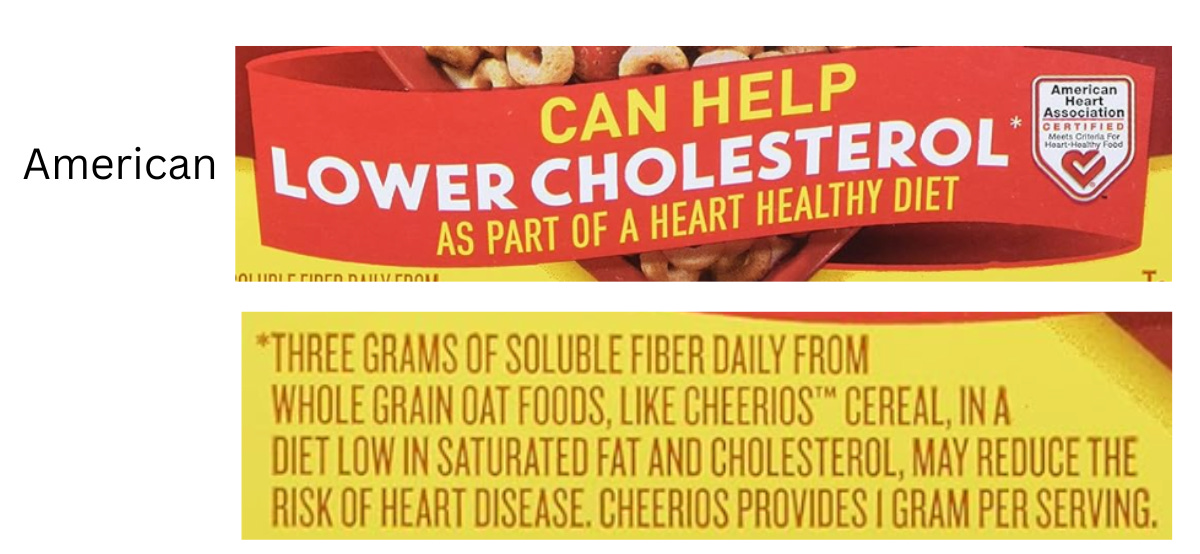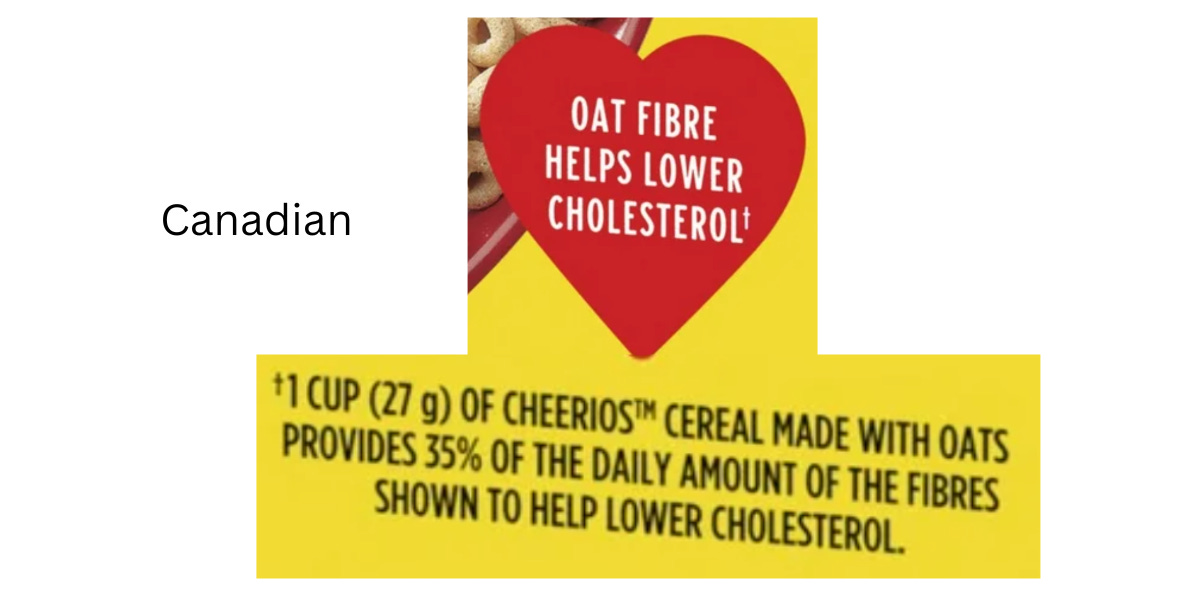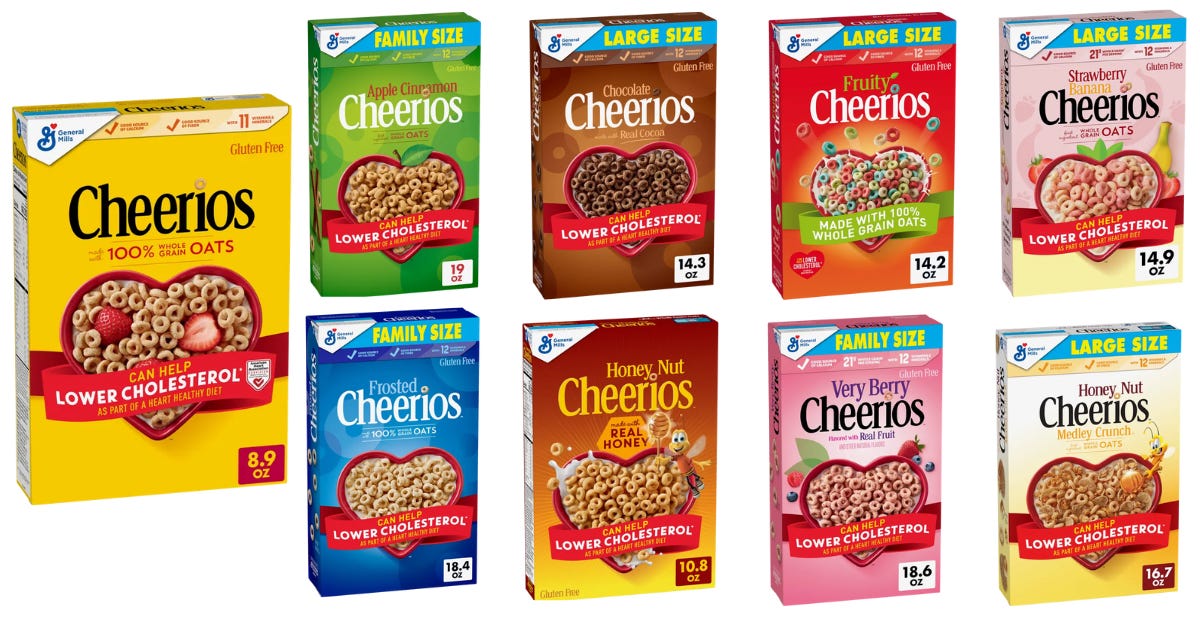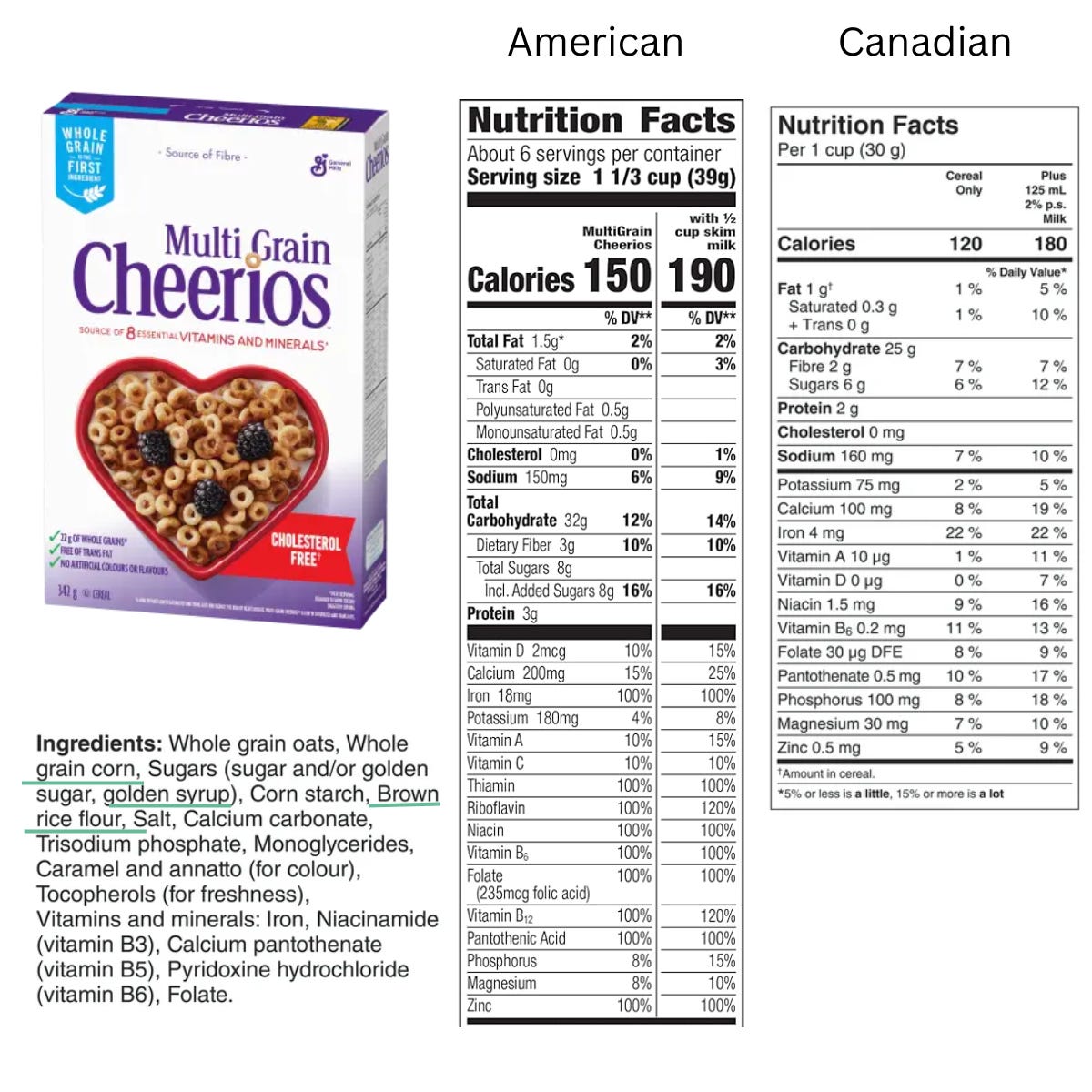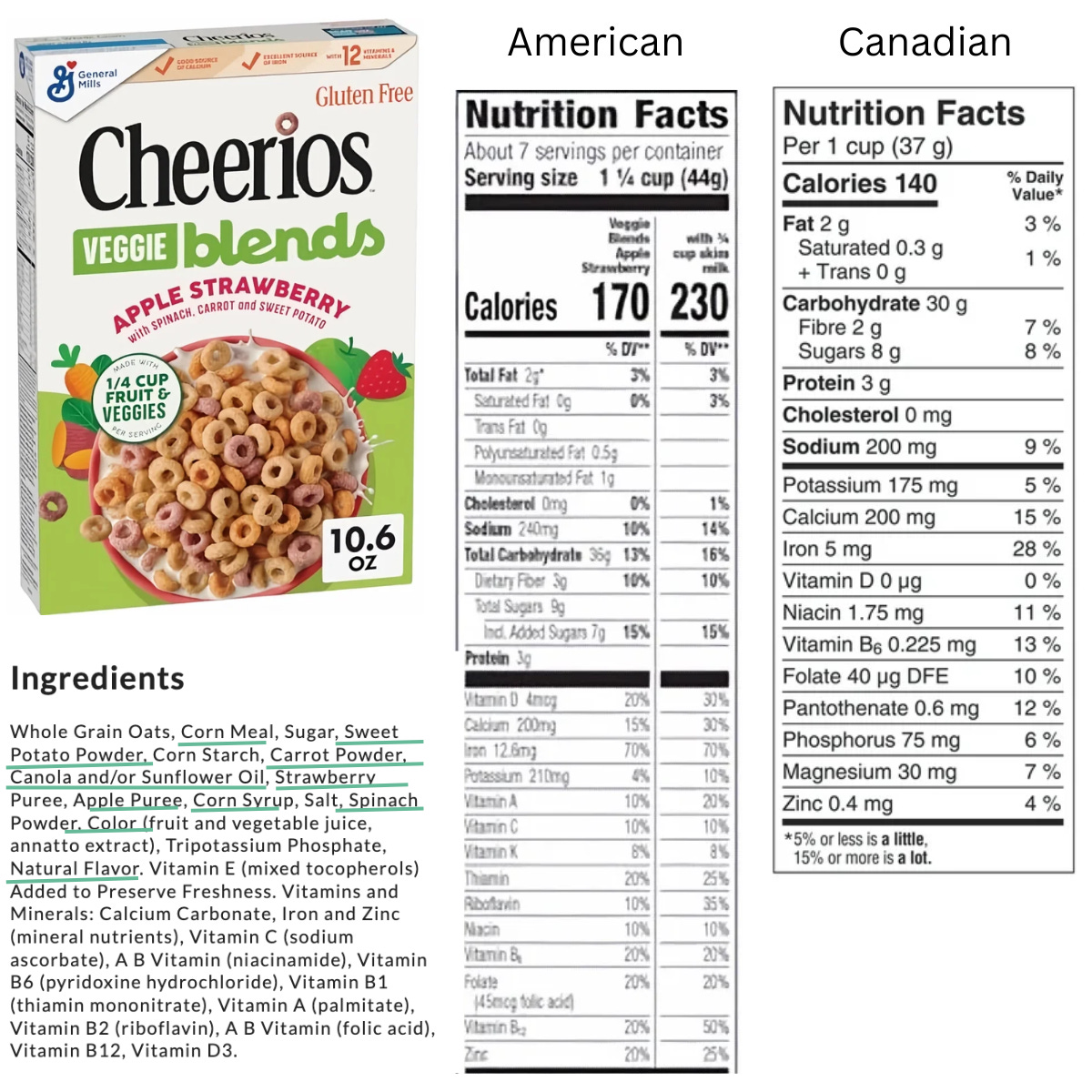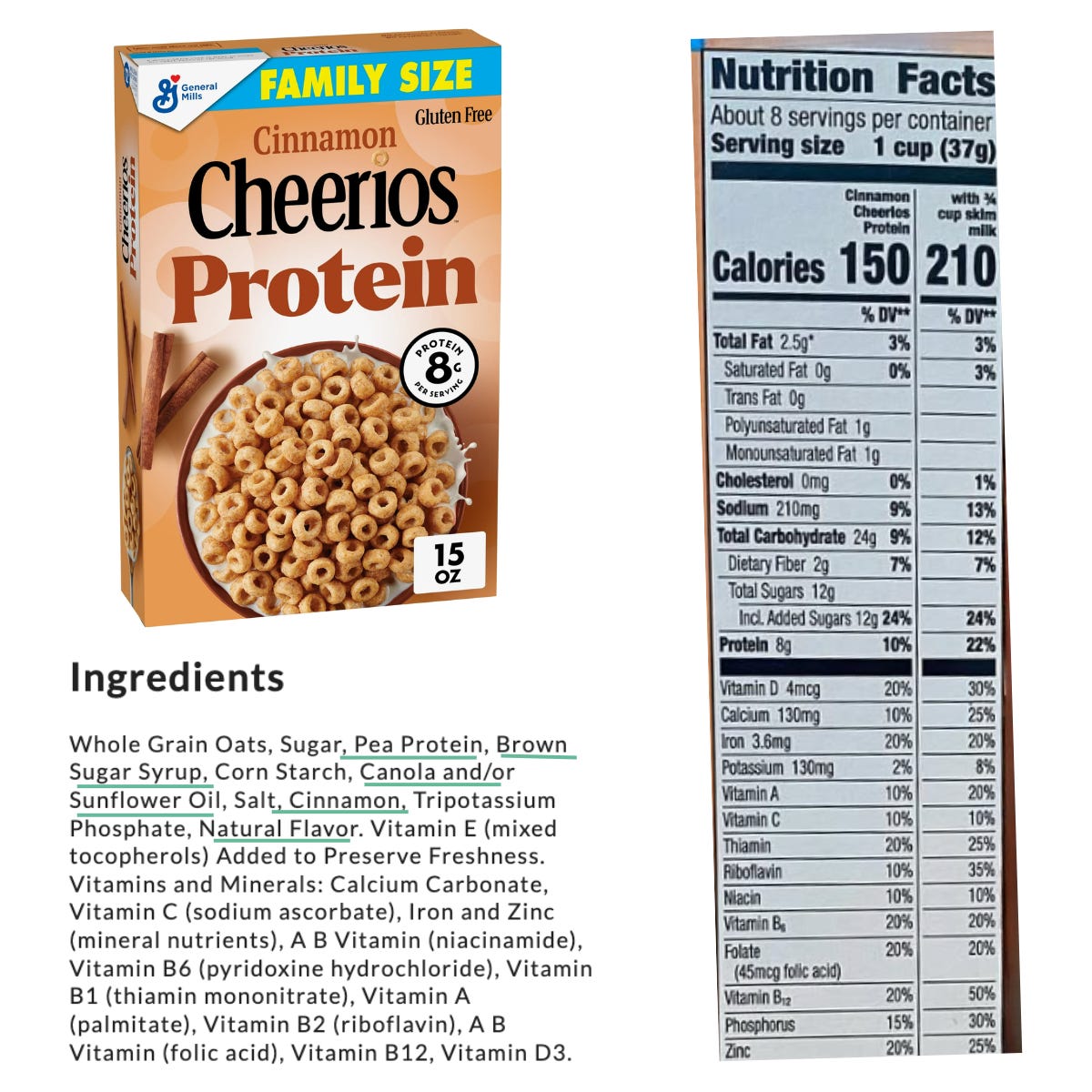Are Cheerios heart-healthy? Review of the cholesterol claim and Cheerios product line.
Oats and cholesterol health claim, review of Cheerios original, sweetened, Multigrain, Veggie blends, and Protein flavours.
Hello, readers! In this week’s edit, I’m reviewing the Cheerios cold cereal product line. I was going to include Cheerios in my last product review roundup, but I realized that a brand this big deserves much more than a brief 200-word summary.
Is there a cereal brand more iconic than Cheerios? It’s one of the most popular cereal brands, backed by its reputation for being heart-healthy. The heart-healthy claims on the front of Cheerios packaging are central to the brand’s identity. Between the cholesterol-lowering claim, the use of a heart-shaped bowl, and the new veggies and protein flavours, it’s no wonder so many people choose Cheerios as a healthy breakfast option.
But are Cheerios actually good for your heart? Read on for my critical review of the Cheerios cold cereal line, including ingredients, health claims, and overall nutrition.
Note: if part of this post gets cut off in your inbox (due to length), click the ‘READ IN APP’ button at the top of this page for the full version.
If you haven’t already done so, hit the Subscribe button below so you don’t miss any future editions of The Grocery Edit!
You can also access previous editions of The Grocery Edit by downloading the free Substack app below.
Since we have American and Canadian friends here, I’ve included examples and information from both labels. But unless otherwise noted, assume the content below applies to both Canada and the U.S.
Cheerios original:
Let’s start with an overview of the original Cheerios. This is the foundation of all Cheerios flavors, as every variety is made with the same core ingredients found in the original.
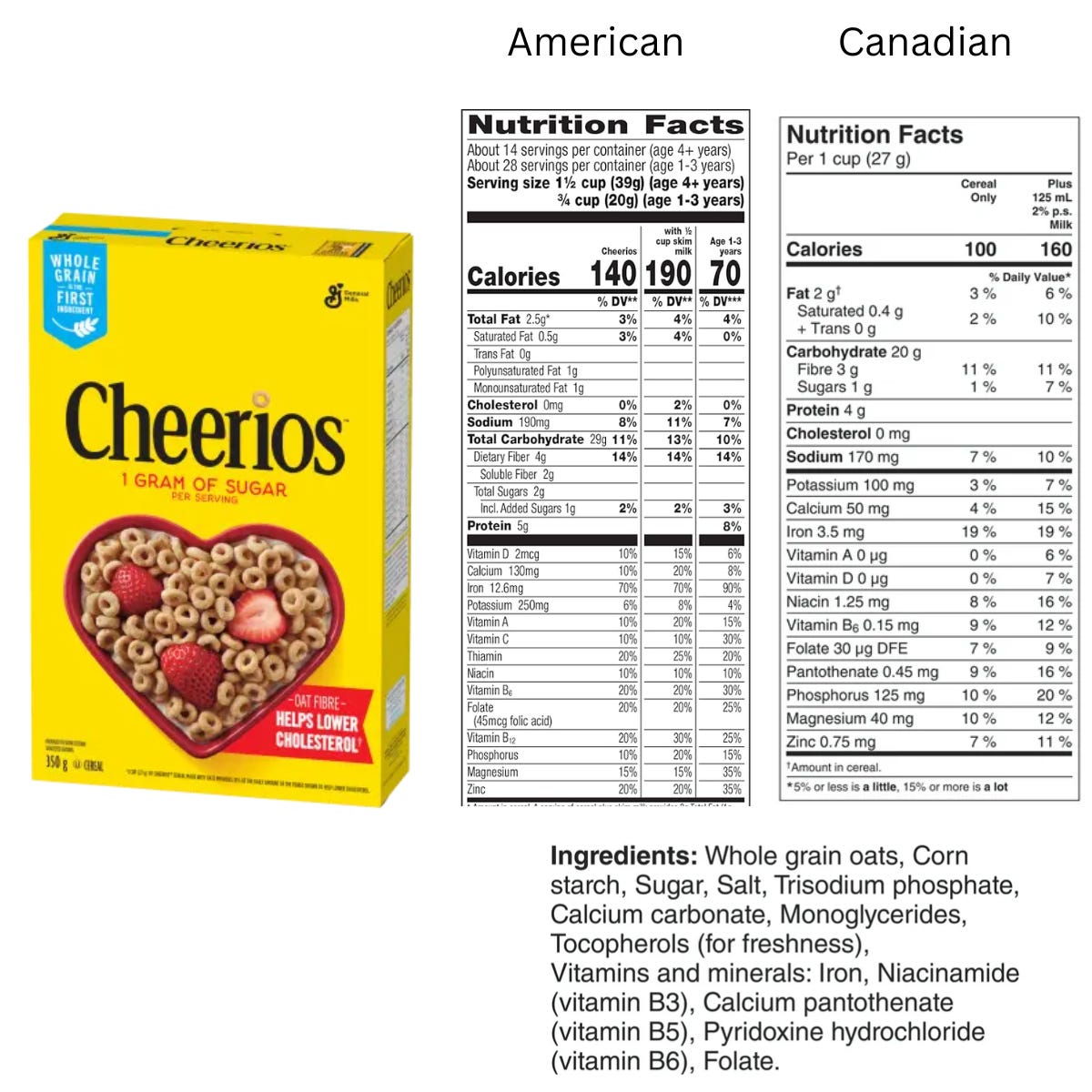
Cheerios core ingredients:
Whole grain oats: The main ingredient in Cheerios, responsible for any potential health benefits. Based on my estimates, there’s roughly the equivalent of 1/2 cup of dry oats in a serving of American Cheerios (1 1/2 cups), and just over 1/3 cup in the Canadian serving (1 cup).
Corn starch: Used as a filler to create a smooth, palatable texture. Based on my estimates, corn starch is used in small amounts, around 1/2 teaspoon per serving.
Sugar: Table sugar is used in very small amounts for flavour, with less than 1/4 tsp per serving of Cheerios.
Salt: There are 170 mg (CA) and 190 mg (US) of added sodium in Cheerios, a low to moderate amount.
Tripotassium phosphate, and calcium carbonate: anti-caking, emulsifying, and stabilizing agents.
Tocopherols: a form of vitamin E with potent antioxidant properties, used to prolong the shelf life of foods.
Cheerios is also fortified with additional vitamins and minerals: iron, and B vitamins
Nutrition Profile
Per 1 1/2-cup serving, Cheerios original contains 2.5 g of fat from oats. It contains 29 g of total carbohydrates, mostly from oats, with smaller amounts from corn starch and sugar. This includes 4 g of fibre from the oats and 2 g of sugar (1 g of added sugar from table sugar). There are 5 g of protein per serving from the oats, along with several vitamins and minerals.
Looking at the nutrition facts table, there’s nothing exceptional about Cheerios. But what sets Cheerios apart from other cold cereals on the market is its beta-glucan content.
Cheerios are low in sugar and a source of fibre—two positive traits of a cereal. But other cereal brands are just as low in sugar and even higher in fibre. What sets Cheerios apart is that they’re made primarily with oats, a source of soluble fibre, specifically beta-glucan, a compound with cholesterol-lowering properties.
Beta-glucan can lower cholesterol by trapping fats in the digestive system, leading to increased excretion and reduced absorption. It also has positive effects on the microbiome, which may further support cholesterol-lowering, though the exact mechanism remains unclear.
FDA Approval of the Oat and Cholesterol Claim
The FDA approved the cholesterol-oat fibre claims in 1997, based on a 1991 clinical trial and a 1992 meta-analysis. The clinical trial used 1, 2, and 3 oz doses of oats and oat bran in subjects with elevated cholesterol. Data from 140 subjects showed that oats and oat bran had LDL and total cholesterol-lowering effects, with the highest oat intervention groups experiencing a 10-11% reduction in LDL from baseline. The meta-analysis of 13 studies also found that beta-glucan had a cholesterol-lowering effect, with the highest reduction of cholesterol occurring in groups with higher baseline cholesterol levels and higher beta-glucan doses of at least 3g/d.
The image above is from the front of an American Cheerios box. The primary health claim statement is: “[Cheerios] can help lower cholesterol as part of a healthy diet”. The secondary statement is: “three grams of soluble fibre daily from whole grain oat foods, like Cheerios cereal, in a diet low in saturated fat and cholesterol, may reduce the risk of heart disease. Cheerios provides 1 gram per serving”.
In the U.S., for a food to use a health claim related to the cholesterol-lowering effects of beta-glucan, the food must:
Meet other “heart-healthy” diet criteria and be low in saturated fat, low in total fat, and low in cholesterol.
Contain at least 0.6 g of soluble fibre per reference amount typically consumed.
Include soluble fibre content on the nutrition facts table (this is listed under fibre and is not otherwise required).
Display a general statement that the food MAY reduce the risk of heart disease as part of an otherwise heart-healthy diet.
Health Canada Approval of the Oat and Cholesterol Claim
The cholesterol-oat fibre claims were approved by Health Canada in 2007. Health Canada considered the studies used by the FDA in their decision years earlier, along with a systematic review prepared by the Program in Food Safety, Nutrition, and Regulatory Affairs at the University of Toronto. This review, which covered literature published from 1995 to 2006, confirmed that an intake of 3 g of beta-glucan led to a reduction in LDL, though the reduction ranged from 0.145 to 4% and no dose-response relationship was found.
The image above is from a Canadian Cheerios box. The primary health claim statement is “Oat fibre helps lower cholesterol”. The secondary statement is : 1 cup of Cheerios cereal made with oat fibre provides 35% of the daily amount of the fibres shown to help lower cholesterol.”
In Canada, for a food to use a health claim related to the cholesterol-lowering effects of beta-glucan, the food must:
Contain at least 0.75 g beta-glucan fibre per typical serving consumed.
Contain less than 100 mg of cholesterol.
Contain 0.5% or less of alcohol.
Contain 480 mg or less of sodium.
Be low in saturated fat.
Include a statement with the percent of fibre that a serving of the food supplies (compared to the 3 g of beta-glucan needed to lower cholesterol).
Since these claims were approved, studies have consistently confirmed that oats are beneficial for cholesterol levels, though the extent of their benefit remains less certain.
More recent reviews1 have continued to report a statistically significant reduction in total cholesterol and LDL from beta-glucan interventions. The extent of the reduction varies, with mean reductions typically falling around 0.25 mmol/L, and greater reductions generally observed in those with higher baseline cholesterol levels. A consistent dose-response relationship has not been observed2, but a dose of at least 3 g/day tends to be sufficient to achieve some level of cholesterol reduction, supporting the current “daily dose” required for the cholesterol-lowering claim.
While the benefit of oat fibre seems clear, our government has missed considering SUGAR content as part of the cholesterol-lowering claim requirements.
The main nutritional difference between Cheerios original and the sweetened varieties is the sugar content, with 11-12 g of sugar per serving. For reference, a 1-cup serving of Trix cereal has 10 g of sugar, and a 1-cup serving of Froot Loops has 14 g of sugar. While the oat fibre and cholesterol claim is restricted to foods that are also low in total fat and saturated fat, there are no restrictions on sugar content. This means the same heart-health claim featured on original Cheerios is also featured on several sweetened varieties (pictured below).
Flavoured Cheerios contain up to 48% of the daily recommended intake of added sugar for a “heart-healthy diet”.
The American Heart Association (AHA) and the Heart and Stroke Foundation of Canada (HSF) recommend limiting added sugar intake to ideally less than 6%, and 5% of total energy, respectively. For a 2,000-calorie diet, that’s 25–30g of added sugar daily. This means, by AHA and HSF standards, the sweetened cheerios pictured above contain 36 to 48% of the daily recommended added sugar intake.
Understandably, sugar isn’t part of the original cholesterol-lowering claim, as sugar wasn’t exactly on our radar in the late '90s and early '00s. But we know more now, and these claims need an update. Regardless of fibre content, when a box of Frosted Cheerios (or the beloved Honey Nut) with the same sugar content as Frosted Flakes is labelled with a heart-healthy claim, it’s confusing for consumers and leads to a lack of trust between shoppers and the agencies in place to guide us.
TL; DR: Are Cheerios a heart-healthy option?
Yes, and no. Cheerios original provides around 35% (just over 1 g) of the beta-glucan consistently shown to lower cholesterol. This is a significant amount of beta-glucan, so Cheerios can certainly contribute positively to an otherwise "heart-healthy" diet. However, the extent to which increasing your beta-glucan intake will lower your cholesterol levels is less certain. Flavoured Cheerios are high in sugar, with 11-12 g of added sugar per 1-cup serving, which is not in line with current heart-healthy diet guidelines.
Of course consuming the source—rolled or steel cut oats, is an excellent way to increase your intake of beta-glucan. But Cheerios original is a suitable alternative for those who prefer cold cereal.
Cheerios also offers a range of products that do not feature the oat and cholesterol-related claim.
Multigrain Cheerios Review
Multigrain Cheerios are another widely popular Cheerios flavour. They contain the same core ingredients as the original Cheerios, with some additions (highlighted in the photo below).
The additional grains added here—corn and brown rice—don’t contribute much nutritional value to the end product. Ironically, the addition of “multigrains” actually results in a lower beta-glucan content and reduced overall fibre content. As a result, this flavour no longer qualifies for the cholesterol-lowering claim. And in my opinion, calling this cereal “multigrain” because it contains some corn flour and brown rice flour is a stretch and feels misleading. Multigrain Cheerios are also higher in sugar compared to the original, though they’re lower in sugar than the previously mentioned sweetened flavours, with 8g (US) and 6g (CA) of sugar per serving.
The Canadian version of Multigrain Cheerios (pictured above) carries a heart-health claim, “cholesterol-free.” I don’t agree with the use of this claim. In my opinion, it’s been added simply to maintain the cereal’s association with being heart-healthy (since most consumers will see the heart symbol without reading the actual claim). However, make no mistake—this is pure marketing. All Cheerios, and most cereals for that matter, are cholesterol-free3. Cholesterol comes from animal products, so unless you’re eating some “beefy egg O’s” I’ve never heard of, it’s probably not a source of cholesterol.
TL;DR: Are Multigrain Cheerios a good option?
Multigrain Cheerios are lower in fibre and higher in sugar than the original version, and they don't provide a significant amount of beta-glucan. If you're looking to reap the benefits of beta-glucan, stick with the original Cheerios. Otherwise, there are many alternatives that are higher in fibre and lower in sugar.
Cheerios Veggie Blends Review
Cheerios Veggie blends are a newer addition to the Cheerios lineup. They contain the same core ingredients as the original Cheerios, with some additions (highlighted in the photo below).
Cheerios Veggie Blends (apple-strawberry flavour) contain the following vegetable ingredients: corn flour, sweet potato powder, carrot powder, and a smaller amount of spinach powder. Veggie Blends also contains canola and/or sunflower oil in trace amounts, which do not contribute significant nutritional value to the end product. The cereal is flavoured with apple puree, strawberry puree, and natural flavours (you can read more about natural flavours in my previous post here). It is sweetened with corn syrup and coloured using fruit and vegetable juice, as well as annatto.
American claim (pictured above): “made with 1/4 cup of fruits and veggies per serving” is regulated. Legally, an ingredient claim such as this can be used as long as they are not deceitful (the product must exist in the food) and they are not implying nutrient content.
Canadian claim: “made with real fruits and veggies” is also regulated. This is allowed on packaging as long as these ingredients are present in the food, regardless of what form (for example, frozen, powdered, ground, concentrated).
I appreciate Cheerios' effort to add veggies and fruit here. It’s no secret that most of us don’t get enough fruits and vegetables in our diet, and I firmly believe that adding more of them, in any form, is generally a positive thing. However, the fruits and veggies in this product don’t seem to make a meaningful difference in the nutritional content.
When comparing Cheerios Veggie Blends to the original Cheerios, they’re higher in calcium (possibly from the addition of spinach powder), but they have less fibre and are equal to or lower in most micronutrients we would expect from the added veggies, such as vitamins A, C, and potassium. This suggests that the majority of the nutrients come from the core ingredients and fortification, rather than the actual fruits and vegetables. Not to mention, they contain more added sugar per serving.
TL;DR: Are Cheerios Veggie blends a good option?
The vegetables added to Cheerios Veggie Blends don't significantly impact the nutritional value. This cereal is also lower in fibre compared to the original Cheerios and contains more added sugar. If you're looking to benefit from beta-glucan, stick with the original Cheerios. Otherwise, there are many alternatives that offer higher fibre and lower sugar content.
Cheerios Protein Review
Lastly, Cheerios Protein is a newer (reformulated) addition to the Cheerios lineup. They contain the same core ingredients as the original Cheerios, with some additions (highlighted in the photo below).
A lawsuit was filed in the U.S. in 2015 against General Mills’ Protein Cheerios for misleading customers by using a similar protein claim. Protein Cheerios listed 11g of protein on the front of the package, which included the protein content of milk. The settlement required General Mills to stop adding the protein content of milk when advertising the protein content on the front of Cheerios Protein boxes. Above is the newly formulated Cheerios Protein, with 8g of protein per serving.
Cheerios Protein contains 8g of protein from whole grains and pea protein powder. For context, the original Cheerios has 4–5g of protein per serving. They also contain a negligible amount of canola and/or sunflower oil. The cereal is sweetened with 12g of table sugar and brown sugar syrup, and flavoured with natural flavours and cinnamon. Compared to the original Cheerios, it has a lower fibre content, with only 2g per serving.
TL;DR: Are Cheerios Protein a good option?
Adding protein to this cereal is generally a positive, but this cereal has a low fibre and high sugar content. If you're looking to benefit from beta-glucan, stick with the original Cheerios. Otherwise, I suggest opting for a low-sugar, high-fibre cereal instead. To boost the protein content of your cereal, try adding protein powder or pairing it with a protein-rich food like eggs or Greek yogurt.
What do you think about Cheerios? I’d love to hear your opinion—you can leave a comment using the button below or the Substack chat.
Know someone who would enjoy The Grocery Edit? Help spread the word by liking and sharing it below! 👇
“The Grocery Edit” is written by Brittany Raftis, MScFN, RD. She works as a Registered Dietitian and is passionate about helping people sort through the confusion of ingredients and nutrition facts to reduce stress surrounding daily food choices. She uses an evidence-based approach to clear up misinformation about nutrition and help people select the right products to support their health and enjoyment of food.
Additional sources:
Sodium Phosphate, Tribasic. U. S Food & Drug Administration, Substances Added to Food. Updated October, 2024.
List of Permitted Emulsifying, Gelling, Stabilizing or Thickening Agents. Health Canada. Updated December, 2024.
List of Permitted Preservatives, Health Canada. Updated December, 2024.
Tocopherols. U. S Food & Drug Administration, Substances Added to Food. Updated October, 2024.
Nakashima A, Yamada K, Iwata O, Sugimoto R, Atsuji K, Ogawa T, Ishibashi-Ohgo N, Suzuki K. β-Glucan in Foods and Its Physiological Functions. J Nutr Sci Vitaminol (Tokyo). 2018;64(1):8-17. doi: 10.3177/jnsv.64.8. PMID: 29491277.
Joyce SA, Kamil A, Fleige L, Gahan CGM. The Cholesterol-Lowering Effect of Oats and Oat Beta Glucan: Modes of Action and Potential Role of Bile Acids and the Microbiome. Front Nutr. 2019 Nov 27;6:171. doi: 10.3389/fnut.2019.00171. PMID: 31828074
Dose-response: more fibre = greater reduction of cholesterol.
An exception could be a cereal made with significant dairy, though I can’t think of one that exists. In any case, traditional cereals are typically cholesterol-free.





